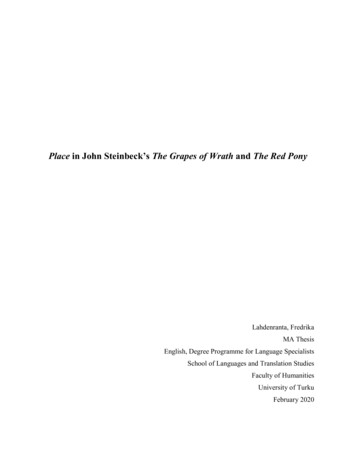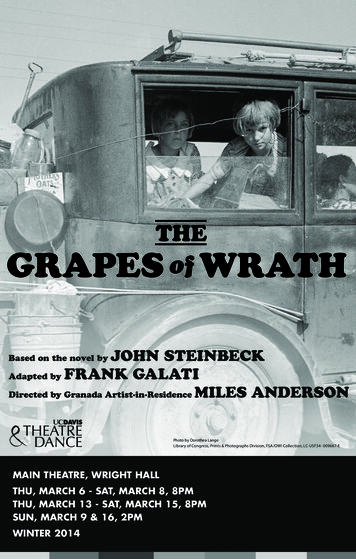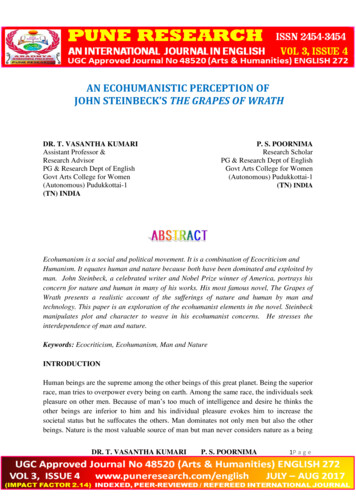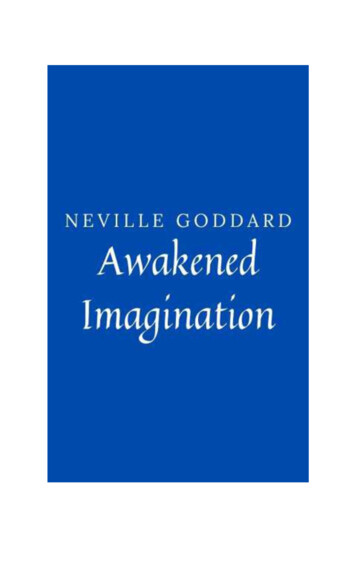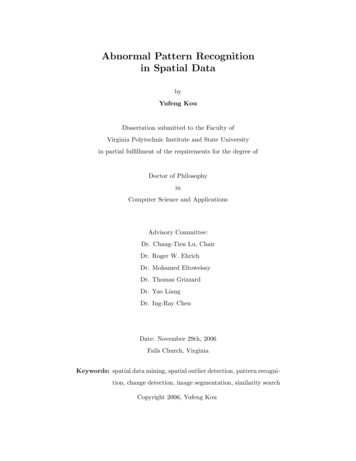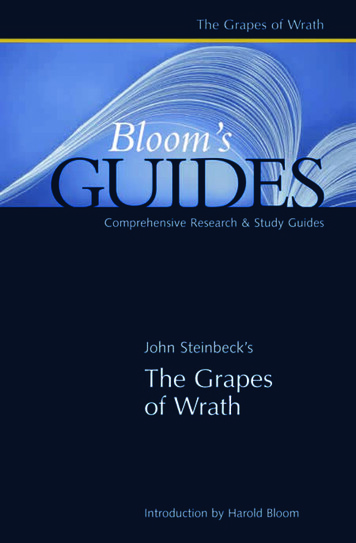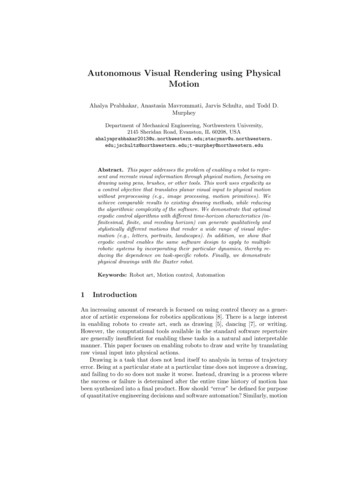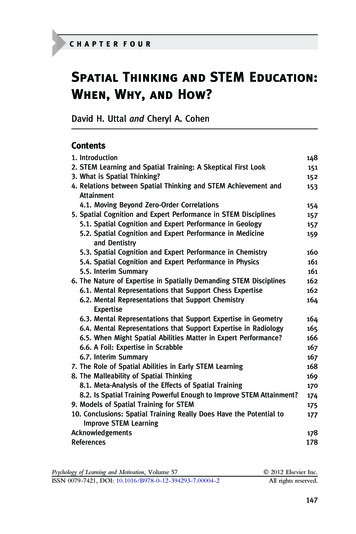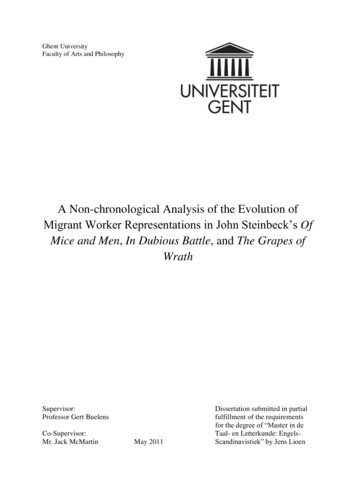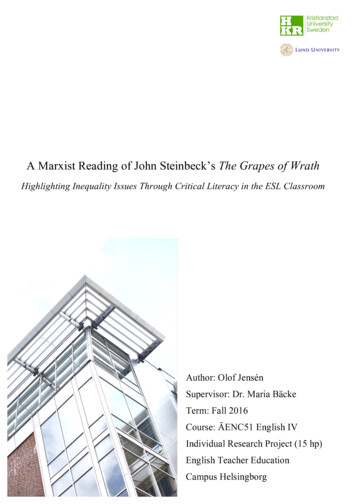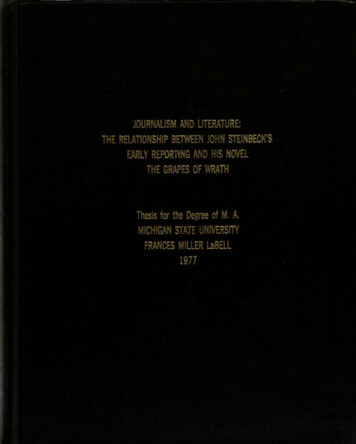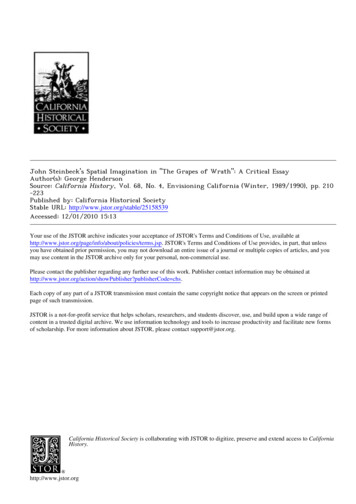
Transcription
John Steinbeck's Spatial Imagination in "The Grapes of Wrath": A Critical EssayAuthor(s): George HendersonSource: California History, Vol. 68, No. 4, Envisioning California (Winter, 1989/1990), pp. 210-223Published by: California Historical SocietyStable URL: http://www.jstor.org/stable/25158539Accessed: 12/01/2010 15:13Your use of the JSTOR archive indicates your acceptance of JSTOR's Terms and Conditions of Use, available rms.jsp. JSTOR's Terms and Conditions of Use provides, in part, that unlessyou have obtained prior permission, you may not download an entire issue of a journal or multiple copies of articles, and youmay use content in the JSTOR archive only for your personal, non-commercial use.Please contact the publisher regarding any further use of this work. Publisher contact information may be obtained herCode chs.Each copy of any part of a JSTOR transmission must contain the same copyright notice that appears on the screen or printedpage of such transmission.JSTOR is a not-for-profit service that helps scholars, researchers, and students discover, use, and build upon a wide range ofcontent in a trusted digital archive. We use information technology and tools to increase productivity and facilitate new formsof scholarship. For more information about JSTOR, please contact support@jstor.org.California Historical Society is collaborating with JSTOR to digitize, preserve and extend access to CaliforniaHistory.http://www.jstor.org
NQp*4v \\\\\a mMsI Ib1Sh 1Hk j li BDust-Bowl refugee migrant workers picking cotton in California during the 1930s. Thisillustration and others in this article are by the great American artist Thomas Hart Benton,from the Limited Editions Club edition of TTzeGrapes 0/Wnrtfc (1940). Courtesy The LimitedEditions Club and the Steinbeck Research Center, San Jose State University210 CALIFORNIA HISTORY
III. Literary CaliforniaJohnSteinbeck'sTheGrapesA CRITICALofinImaginationSpatialWrath:ESSAYby George HendersonIntroduction:as Social Action.Representationran "HarvestGypsies,"commissionedarticles,byNewswinter of 1937-38 was especially wet in theSan Joaquin Valley. Steady and heavy rainssaturated the San Joaquin flood plain, particTheularlyin cotton-growingMaderaCounty.ruary of that winter John Steinbeck wroteagent Elizabeth Otis:In Febto hisImust go over into the interior valleys. There arefamilies starving to death overabout five thousandthere, not just hungry but actuallystarving. Theis trying to feed them and get medicalgovernmentto them with the fascist group of utilitiesattentionand banks and huge growers sabotagingthe thingall along the line and yelling for a balanced budget.In one tent there are twenty peoplequarantinedare to havefor smallpoxand two of the womenI've tied into the thingbabies in that tent this week.onfrom the first and Imust knock these murderersthe heads. Do you know whatthey're afraid of?They think that if these people are allowed to livein camps with proper sanitary facilities,they willorganize and that is the bugbear of the large landowner and the corporationfarmer. The states andcounties will give them nothingbecausethey areBut the crops of any part of this stateoutsiders.could not be harvestedwithoutthese outsiders.I'm pretty mad about it. No word of this outsidebecause when Ihave finished my job the jolly oldassociated(Steinbeckfarmers willand Wallsten,beafter myscalpagainFor several years Steinbeck had been eyeing thesituation"interiorrial writer (see St. Pierre, 79-81 for excerpts). Inthose brief pieces a reader could find most of themajor themes about California agriculture thatSteinbeck would later chronicle in The Grapes ofWrath in 1939.Shortly after "Harvest Gypsies" was printed,Steinbeck's Of Mice andMen and In Dubious Battleappearedin the bookstores.of migrantin valleys."Battle wasIn Dubiousselected by the Book of theMonth Club, and withina month one hundred thousand copies had beenpurchased.Bothnovelsconcernedcoststhe socialand unique social formations that Steinbeck attributed to the system of corporate agriculture in thevalley (St. Pierre, 81). Thus, by the time SteinbeckbeganThe GrapesofWrath,his visionwaskeenandhis hand well practiced.The new novel beganto take on a spectacularlifeof its own. Six monthsafter publication,twowhenhundredthousandcopies had been sold, Commona book sells likewealth magazinenotedthat "whencausesitandwhencommentand henomenonof importantdimensions.andTheliterarycritical industry of the country is not really gearedto handle it" (quoted in St. Pierre, 98-101). The criticlamented the lack of attention to the book's literarymerit.Mostreadersor not California158).a series of Steinbeck'sthe paper'schief editoonly wantedfor example,(see Kappel,Kern County). Too muchbad,hadWINTER 1989/90 211beento knowwhetherresembled Steinbeck's depictiongearedonthe novel'sbanincriticism, both good andto assessingthefactual
content and background of The Grapes of Wrath.Only in later years did the "pattern of criticism"turn to an assessmentof the novel'storelationshipthemes, such as biblical allegory and the "Wagonsthe late thirties anyone who cared couldDuringhavethe generalcorroboratedAdministrationand Resettlementinducedlabor surplus,the migrantvigilantismtanceif notevents,theHoovervillesdetails, provided by Steinbeck?thecamps,crop specializationgrowerby region,trek from the Dust Bowl states, theand the relief work, and the imporof cottonasthe newOne of the devices by lproductionago:thirty yearsout that "most of theBurke has pointedKennethis to say theircharacters derive their role, whichto thetheirfrompersonality,purelyrelationshipBut what he takes to be a seriousbasic situation."is actually one of the book'sweaknessgreatest(Lisca, "The Grapes ofWrath as Ficaccomplishmentstion,"amigrant736).The Grapes ofWrath was indeed relentlessy didacapparentlyuponoverobservationthe two writers did not collaborate. Aldid, they did not need to refer to the novel in orderto understand the historical reliance of much ofinfusedwithprocess. This point seems to lie behind Peter Lisca'sand convincingIn broadlyprose, Mcsupporteda mirrortext for ent wasto saturatethis thematicanwithof thehis readers' netic,pushas to makein such a waythe story alongeverycharacteraction part of an envelopingand everyhis workThe release of The Grapes ofWrath could not havebeen better timed in relation to the publicationof Carey McWilliams' Factories in the Field n a rootless,authorityclass. The point, then, is that Steinbeck registeredthe duality of history and nature in terms of a socialidiom.West"to vest moraldaredbut by ensuringtic, even formulaic,erstheinvolvedprocessesgraspedas the above quote wouldsituation,"thatthe readthe"basic(orhave it) Steinlabor class. Yet The Grapes ofWrath did fulfill a rolebeck could then suggest how different orders ofas aexperienceofvirtueattachmenttext.and social realistinterpretiveregionalistas a documentstandsof social change.The novelmorecan be askedof it.Nonetheless,to turn to aitmightbe interestingFor example,problem of the human condition that Steinbeckapparently set up in The Grapes ofWrath. One ofwasconcernsto reprefundamentalSteinbeck'stofamiliessent the migrationof white midwesternas part of that recurrentcondihumanCaliforniaitselfconditionthat the humantion, whilearguingandsocialis shapedhistoricalcontingencies.byHe asked what relationshipthe laws of nature hadnaturedoes not tranto human-madesituations:nor doesscend or determinesuperhistoryhistory,accountsI think,for theThissede nature.idea,characof some of Steinbeck'simmortalqualitiesters. At the same time, only the historicalmoment,could revealof social relationships,the interventionwhat might be enduringlywillto survive?tohumanizetrue: Ma Joad's heroicthe naturalsurvivalthreat.by economiconly manifestedin a tranbeliefultimateand Casy'sTom Joad'swasout onlyhammeredhumanscendentfamilyinstinct?wasby virtue of their ability to gaugejust howfarthe local situation.had lmigrantssocial relationsand invertingmakers,by phrasingspecificallythemes,local questionsfueledhis detractors,in terms of grandiosewhowouldnot haveand containedothersbyrepresentedfor example,the overarchingcauses;a wholesomenessto land representedof body and spirit.Whatalsois inherently geographicalturnstuting,out to be inherentlysocial, both constiisand constitutiveof, the same processes.ltfrom social and geographicalrelationshipsthatrather than from an individualradiates,meaningor action.characterwerewithIn this waysmall detailschargedoutandrepresentinglarger processes.bearingThis seemsalike just the sort of thing befittingphilosophicalargumentof naturalism.Butitshould not be forgotten that itwas the modernizationformsand its attendantof agriculturalproductionof consciousnessthat, Steinbeckbroughtargued,in particularthat aspectthis state of affairs;aboutof modernizationchangetechnologicalwherebyinto contactloosensboundaries,formerlybringsfor a seemand allowsdiscretethings and persons,ingly small event to be nestedmoresignificant.Theparticularinside somethingimportanceof themodernizing process as detailed by Steinbeck wasthat it foreshadowed(the powerrepresentationto grasp cognitively the rending and reshufflingitself as a precursorsocial bonds)of traditionalfor thedilemmato social action. A fundamentalof their own dailythe inappropriatenessJoads wasto an interpretationof theand practicesthoughtwasneworder. Nowhereand economicpolitical212 CALIFORNIA HISTORY
thiscontradictionmoreevidentthanin the endless bickering over the value of talking over theirproblems. Steinbeck himself took on the problemas thereof representationinsofarinterchaptersasanarratedthe storyform of documentation.becameMoreover,representationby the end ofthe novelboth a narrativeand a form ofstrategysocial action.these generalI wantto exploreTakingpoints,ahowkindofthey conferredimaginaparticularto Steinbeck'stive processoftheTheGrapeswritingThisorchestratedthe geoof Wrath.imaginationsites and the situationof charactersdegraphicalin the novel,the particularsocial processespictedasacrossspace, whichthey unfoldedonly peopleinthecould haveprocessswept upmodernizingunderstood.Grapes ofWrath cannot be understoodTheunlessthe charactersareseenfullyto developrelationship to the places through whichintheythat they also reconstituted,if onlyto be a genThis approachis meantmomentarily.one and notan argueral, illuminatingnecessarilymentto be sustainedfor each character.Rather,the interpretativein theactionaddressesapproachas esproportion of the thematic load of the novel fromsuch a perspective, the bulk of my discussion willfocus on him.in at you cannot understandis goingwhatinside Californiaunlessis occurringyou know whatoutside.out by the novel'sThis notion was borneconcernwith mappingthe Joads'overwhelmingacross the westernstates. Giventhe fammigrationafarm in Califorily's goal of obtainingfamily-sizethat the Joads nevernia, it could be arguedreallywerewhereThe migrationgotupontheygoing.whichhas no conclusionin thethey embarkednovel other than an ironic p"ending.The Grapes ofWrath was finally not just a geographicproduct,important,but wasthen,laden withIt issocial meaning.to movethe line of questioningaway from how the Joads got from one place to theand by whichtoward how meaningnext,routes,is ndspace. Also,regardworkadayneedto ato discover wheregeneraltheorysociety. Specifically,Steinbeckgeographicof placeSteinbeckformationI wouldsat in regardincapitalistlike to show howdemonstratedhis awarenessof social/astheoutcomemediumandthespaceof certain processes: the division of labor alongclass and gender lines; the territorial demands ofcapitalist agribusiness; and family and communityspace for their own producand privateThesefulfillment.tion, ,byto appropriateneedsto bear on the Joads' travails as theybroughtencounteredthe widersocial worldand it, in turn,or resistedreceivedtheir arrival.In a sense my outlookas toobe criticizedmayeconomistic.state at the onsetLet methat I amsomefamiliar withof the commonculturalandideological idioms of Steinbeck's work, includingthemyth of the garden, the family farm as a reformistideal,andof womenthe closenessto nature.WhileSteinbeck appeared to have left these myths intact,and indeed to have relied upon them, he dismantledothers of a specific local and regional character: theinnocenceof California'sagriculturalfamilyfarm as a basicunitthebounty,myth of an egalitarian frontier in theWest,of democracy.and theofInsteadtreating each of the above concepts explicitly, Iwillsimply let them inform my thinking, drawing onas necessaryorappropriate.I think, structuredthe meaningsof dplaceson two levels.took on meaningFirst, each placethemthrough its dynamic relationship with an oppositekind ofeither real or imagined.theSecond,place,interactionof these polaritiesor overtransformedturnedsocial relations.can twoHow"interact"?Contradictionsplacesthe processesof the divisionof labor, capiamongtalist agribusiness,and small social unitsarise aseach assertsits territorialdemandsfor space?to its charactersintodialecticalplaceslationship. Withactingplacesthe notion of dialecticallyin mind,Iwould,sets of oppositions which typifythe primaryamongThese he relationshipsin The GrapesofWrath.majorliterary devicesthrough which Steinbeck represented the processesof the creation ofspace. The threesocial/geographicsets of oppositionsare:1. The tensionbetweenispowerplaces wherecentered?orof sociallyrepresented?andplacesmarginal2.activity for rniaas avisible, knowable, Edenic landscape and the Joads'invisibility and ignorance within it;3. The conflict betweendivergent modes oftransforminghabitats.WINTER 1989/90 213natureandproducinghumane
fy p.-. ** ' SIISnH H B'? S ? HHfn lCaliforniagrowers'ofmigrantexpl?ltationin the1930swaslaborersmac*epossibleby supportI' E lK W il H filBBBI: .AxV% WMll P B P 9il9L*W J&Sr SPJrlP il MSiMfiilKm K h Sl /P Hi9HtaflMH HH&BBPi?Ea HB l#y t vCH mP # 1HHI BBfctttp igHP fj/LimitedEditionsClubV V HH Jn rompublic authorities. In s lustrationfromtheeditionof TTieGrapesofWrath r B RJ HsSbdJHMfslHL'""*Portraysa state policeman?9 91HHH SW IK SBLJVmH HflV HB x N B iB H HJHH&MBflPSMb'-W? HH Kjj Hp &UH HHH SS H RLSflP P H H vJljR Hi H pPJ y Q HN HR bHPt P Hi l B MEsM HL J MIPlaces ofCentralized Power andMarginalized Activity.Theof powergeographyanddisenfranchisement is relatively straightforward in The Grapesis drawnof Wrath. A primary implication,antagoniststhe onewhichthe funcomprisedwasin Steinbeck'sbook,that finance capital, fixed in placesandthe entrenchedandhand,camps on the otherRoutes 66/99 and the migranturbansettlementboth hostile to the "independent"(the banks),patternwereand dispossessedrural smallholderand migrantworker.Oklahomaon smallto foreclosebanks extendedtheir domainor mid-sizetownsCaliforniaresistedfarms, whilethe onslaughtwereof the displaced migrants. Migrantthus pushedfrom two directions:fromtheirhomelandsand awayfrom eared that the Joads wouldfind a place inwhichtolengedand a tyrivaledthe exclusiveclaimsto authenticity held by the historically validated, pre-existingin whichmoralandpattern,authoritywerein fixed centers,vestedeitherpowerpoliticaltowns or farms. Steinbeckreversedandthis notionsettlementa vision of moral purity and impendingpolitical power as they were taking shape on theoutlinedroad:The cars of the migrantpeople crawled out of theside roads onto the great cross-countryhighway,and they took the migrant way to the West.In thetoscuttledlikewestward:thedaylighttheybugsand as the dark caught them, they clusteredlike. . . Thusitbugs near to shelter and to watermight be that one family camped near a spring, andanother campedfor the spring and for company,and a third becausetwo families had pioneeredthethe sun wentplace and found it good. And whenfamilies and twenty carsdown,twentyperhapswerethere.into power,whereasupbelong.Fixity translatedwasrootednessthe best assuranceof continueddisenfranchisement.Fromthis point,Steinbeckwrote what mightbe called a drama of settlement.in theThe settlementdrama has two dimensionsa reinventionIn one, Steinbecknovel.ofimagineda natural,formedtheorganicsocietyexigenciesbya strangeIn the eveningthething .werethe children of all .esthat make a world,Every night relationshipstorn downthe worldtablished; and every morninglike a circus . . . graduallythe techniqueof buildworldsbecametheirThenleadersingtechnique.then laws were made,then codes cameemerged,. .into being.(p. 264-5).Roadside."Steinbeckof the highwayThislife alongnew,the "Great Americantransitionalsocietybothchal214 CALIFORNIA HISTORYwroteinto the situationa sort of moral
Yet themodernization.ous statusin the novel.time as it restrained.was simply that the basic social rules, forgotten byproposedsociallynots. Awasgleoverlaidera West:Route 66 wasanew. Thisbe learnedresistedthosewho werebythe havehavestheagainstwell-placed:and mediumfor this strugmanifestationform of socialthe newrelationsspatialon theofthenew,depressionlandscapethe dominantsociety,waschangemusta circularCaliforniaa narrowwaythe greatfantasy isin theto foretell a day of causeby large propertiedwerean "I" frame of mind,instillnot yettheyinto communalliberatedconsciousness.aThe author presentedof fragmentationpatternportentousregroupingthis role is transformedonthe road.from nemesistoward aThe roadto necessity,for allitsfor housesearchandgarcame to,they madetheydown99. It isRouteescapenumberscontentto revealthemselvestheirsymsouth on "99"(p. 384). Turningto "66." The Joads werethe route numberon the samebuthome,essentiallyhighthat used to lead to their old front door.The Joads' Invisibility and Ignorance within a Visible,the raisingof individualizedforms of consciousness to the level of class. Steinbeckwrotethat "oneonefrom the land." Theman,[is] drivenfamily. . . and bewildered."is "aloneButsingle migrantthen somethingTwo men meet,"squathappens.on their hamsand the womenand childrenlisten. . . ." ThisSteinbeckout,meeting,pointedis the "mode"of revolution.T lost my"Here". . .ourland' is changed'Welostland.'[to](p.of the rural freeholder class which movedpre-dawninvertedfar fromsocialits laws had beenbecauserevisedleveler,to accommodatelives as lived on the road. In thenewthe trucker wasthe benefactor.landscape,wasof the newSteinbeckenamoredroadsideculture?thethe truckers,the truckstopsdiner,as he ridiculedits ounds,peddlingfor ill-gottenprofits.the reasoning"Hooverville"the routeEdeniccontinuedin theirpathyetit led the Joads downden. After the Joads' scrape with the law in the firstbolicoverat this pointin the novel, was one city,land in the West.outculturestretchedMigrantinto a great protectivenet acrossthe roads of thewaswest.Noland the democratizingelelonger206). Steinbeckconsciouness,tempting to think that Steinbeck was manipulatingThe struggle towhich Steinbeck implicitly alluded,of the settlementfor the formation of thesymbolic and cultural weight,267-8).The other dimensionsociallogic ofroad maintainedambiguIt beckonedat the sameessentialnewmigrants'The families, whichthehad been units of whichwere a house at night, a farm by day,boundariesIn the long hot light,their wly westward; but at night they integrated with any groupthey found.asThus they changedtheir social life?changedmancanin the whole universeonlychange. Theywere not farm men any more, but migrant men(p.ment. Rather, geographical mobility wasis to follow the contradictoryif historyon theof Americanborneregenerationsociety,Atbacks of its mostmembers.first,beleaguereda "circus",athe new societybut itseemedparody,inLandscape.critical juncture in the book arrived as theJoads were astride the top of the TehachapiAMountains,lookingoveroutthe CentralValley toward Bakersfield. They had just enduredthe disappointment of Needles ("Gateway to California"), a funeral procession through theMojaveDesert,andthe agriculturalinspectionatstationDaggett:Al jammed on the brake and stopped in the middleof the road, and, "Jesus Christ! Look!" he said. Thethe orchards,the great flat valley, greenvineyards,and beautiful,the trees set in rows, and the farm. .The distant cities, the little towns in thehouses.on theorchardland, and morningsun, golden. . .Theinfieldsthevalleygraingoldenmorning,and the willowtrees in rows.lines, the eucalyptusPa sighed, "I never knowedthey was anythinglike her.". . .Ruthie and Winfieldscrambled down fromthe car, and then they stood, silent and awestruck,. .and Ruthieembarrassedbefore the great valley."It'sCalifornia"whispered,(p. 309-10).This moment,whenof California,spectaclenovel whenthe Joadstheywastookwerethefaced within theforeshadowedaNeeoutsiderespitedles. Tom Joad wondered then whether the imageof California would pan out in reality: Pa said,"Wait till we getTomtry then."to California.admonished,You'll"Jesussee niceChrist,counPa!This here is California" (p. 278).Moments later Tom talked with aman versed in thesubtler aspects of the California landscape. He toldTom whatCalifornia,WINTER 1989/90 215to expect,and althoughhe wasleavinghe encouragedTom to go see for himself:
"She's a nice country. But she was stole a long timeago. You git acrost the desert an' come into theseenAn' you nevercountry aroun' Bakersfield.such purty country?allorchards an' grapes, purtiest country you ever seen. An' you'll pass Ian' flatan' fine with water thirty feet down, and that lan'slayin' fallow. But you can't have none of that Ian'.An'if theyThat's a Lan' and Cattle Company.don't want tawork her, she ain't gonna git worked.You go in there an' plant you a little corn, an' you'llgo to jail!" (p. 279)The migrantsrural paradisehadseendrapedof California?apicturesa snowwithbackcappedground (p. 271). In the scenes depictedJoadsareimage.to confrontbroughtBut even whenthe visibleandabove thequestionlandscapethatseemedto fit the pictorial myth, the social and economicreality had brutal implications. The landscape, aaspresentedspectacle,crest of the Tehachapis,betweencontradictionto the observerfromtheconcealedthe envelopingthe subsistenceofpotentialthe soil and the monopolisticalmost masochisticsurvival"crawl,"of theassertedfortitude,theirblind,(that evidence of theon animalborderingdrive?bugsin the facethe Joads "crawl") whichflewinstinctof everythingtion. They werethey had heard along their migradistrustful(p. 283).Indeed, Uncle John foresaw the truth of their expein the great valley.rienceseen any of theparticularhave been able to map outof "words"andCenter, San Jose State University"talk":IIBfetSBwylwYet he could not havenotand wouldfeaturesthe continuationof theirjourney from the vantage point at the pass in theThe crisis of representationhere hadTehachapis.two expressions.One wasthe inability of the Joadswereto conveyto each other whattheygettinginto. The other expressionthemselvesof the crisiswasthe very landscapepowerthat lay before them. Theto representof the landscape,futureeventsas they would be shaped by social/power relationsand to lend predictability to the migrants'lives,rapidly diminished. The landscape ambiguouslyrevealedand concealedits contents.Joads had been makingcompanies.the Joadslarge landowningStill, however,tendenciesof Needles][Uncle John by the riverbank outside". We'reain'twe?Noneof thisthere,a-goin'here talk gonna keep us from goin' there. When weget there, we'll get there. When we get a job we'llwork, an' when we don't get a job we'll set on ourtail. This here talk ain't gonna do no good no way"Allalong,the equation betweenthethevisibleand the possible,betweenreality and repreassentation.The notionsof "there"and "here"on a map,or as elementsofthefieldofpointsvisionthat could be identified and reached, werecontinuallyobscuredbecausethe Joads wereluredin the first place by the spectacle of California. Or,- Ejj 216 CALIFORNIA HISTORY EaL*
wasCaliforniaspectacle. Whatrather,theyas ato themrevealedonlyin fact, was a parallel,found,though peripheralized, world.The apotheosis of the peripheral world wastheA parodyof the Americansmall-townHooverville.ideal and a continuationof Steinbeck'ssettlementcould be foundthesesettlementssquattermyth,town: "The rag townoutsideof every"real"layweretoandandthe ures,papergreatjunk pile" (p. 319-20). The "rag town" was reallynothing but the discharge point of the effluvia ofthe social"a greatorder:junk pile."Thedescription alluded to the flow of goods, but the Hooveraville madeof real economicmockeryexchange.wasAndtheThe flow of llusory?housesand paperconstructions.Yet it wasprehendedplotin Hoovervillethat the Joads comthe basic contradictions that drove theforward.followedThe migrantcamponthe outskirtsthe "mother of invention" dictum, butan essentialthe camp wasinstrugeographicalainmentlaborfor concentratingregionsurpluswhere one extensivelyplanted crop ripened all ata broad area. In Hooverville,Tom Joad isatoold handabout howlecturedworld-wise,bythe gatheringenabledof surplus workersemployers to pay miserablethem menwages.got"S'pose. . . Jus' offerkids'em a nickel?why,they'll killonceovereach other fightin' for that nickel." The men hadbeen lured by handbills, and "You can print a hell ofa lot of han'bills with what ya save payin' fifteenan hourcentsinstructor.Hefor fiel' work,"continued:explainedTom'sa big son-of-a-bitchof a peach orchard Iin. Takes nine men all the year roun'." He"Takes three thousan' menpausedimpressively. .them peachesis ripe.for two weeks whenTheysend out han'billsall over hell. They need three. Whole.thousan', an' they get six thousan'.parta the country's peaches.All ripe together. Whenone is picked.ever' goddamya get 'em picked,There ain't another damn thing in that part a thecountry to do. An' then them owners don' want. Soyou there no more.they kick you out, theymove you along. That's how it is" (p. 334r-5)."They'sworkedThe Californiaspectaclewasrevealedas a horrificproduction racket involving key combinations: adivision of labor with a painfully seasonal andextensivespatial underpinning,mono-cropping,and the short term needsof migrantfamiliesindividualsto keeptogether. Althoughporary arrangementthe diurnal bodyandand soulwas a temany one Hoovervillein the migrantHooverworld,to be found on the edge of every town.villes wereEach was fragile overwereextensivetheytime. Over geographicaland threatening.Thus,spacetheyhad their hand in a dialectical turn of events: "everyraid on a Hooverville,every deputy swaggeringthrough a ragged camp put off the day a little andcemented the inevitability of the day [when theland will belong to the workers]" (p. 325).Just as the Joads wereawedand(embarinspiredrassed too) by the view of the landscape from atopvisionof an ordered,ownersworld?thethe Tehachapis?ative, and beneficientproducof property, the producers of that landscape and the imageasof Californiaa havenforthedispossessed,wished to keep the migrants moving. The landscape itself was to be a fixed, closed entity, and thewasto keepidea of keepingthe outcastsmovingfrom thinkingof them as part of the real picture.as ato definethe laborer merelyThe point wasmeansof theof productionrather than as inheritorone of whichrewardsof an agrariantradition,to thewouldbe the very privilege of belonginglandscape by being a Ironically,ship.understandstheses ofdispossessed,But workersneedformparticularlandknowledge?toit is the greatlandownerwhothat whenthere are maslessonwillfollow.revolutionsurelyto grasptheir role in the historical process. How does the workercomeintoasJoadspeasants"workers"?Wrathof conownerin The Grapes ofthat consciousness?that theyknowdo theHowhave becomeThe Joads were not ascribed any potential forsocial mobility. In addition, their spatial mobilitywasalmostif not prescribed.restricted,thoroughlyaintotheselfabout a realThus,plungebroughtto history and society. In spatialized relationshipseclusionterms,chose equired.carefullya charactera renewedandseetofromwhichsocialpointthat gavevantagecontradictionsfraught withmust bein a positionplaced(p. 571-2).from whichto view their world upside down, withorderreversed.Invariably,theseginal, both in the productivityhierarchyof humanplacesthe socialweremarof nature and in thehabitats.Divergent Modes of Transforming Nature an
Steinbeck would later chronicle in The Grapes of Wrath in 1939. Shortly after "Harvest Gypsies" was printed, Steinbeck's Of Mice and Men and In Dubious Battle appeared in the bookstores. In Dubious Battle was selected by the Book of the Month Club, and withi
